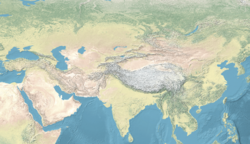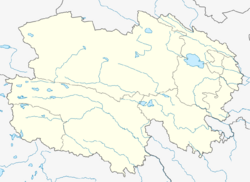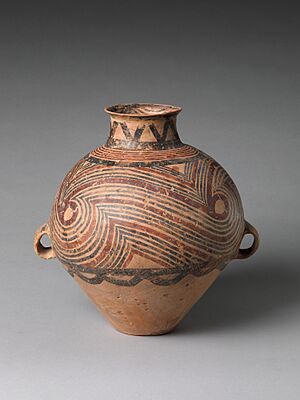Lajia facts for kids
|
喇家
|
|
| Lua error in Module:Wikidata at line 70: attempt to index field 'wikibase' (a nil value). | |
| Alternative name | Lajia Ruins |
|---|---|
| Location | China |
| Region | Qinghai |
| Coordinates | 35°51′51″N 102°48′37″E / 35.86405°N 102.81025°E |
| History | |
| Cultures | Qijia |
| Events | Earthquake Mudslide Flood |
| Site notes | |
| Excavation dates | 1999, 2000, 2001, 2002, 2003, 2004 |
| Management | Lajia Site Museum |
Lajia (Chinese: 喇家; pinyin: Lǎjiā) is an ancient place in China. It's an archaeological site from the Bronze Age, a time when people started using metal. It's located near the Yellow River, between the provinces of Gansu and Qinghai.
The people who lived here were part of the Qijia culture. They mostly grew millet and raised sheep. They also kept pigs for special ceremonies. In 2005, archaeologists found the world's oldest known noodles at this site! Around 1920 BCE, a huge natural disaster buried Lajia. Many people died, and the site was covered in mud.
Contents
Discovering Ancient Lajia
Lajia is linked to the Qijia culture, which lived in northwest China. This culture existed from the late Neolithic (New Stone Age) to the early Bronze Age. This was roughly from 2300 BCE to 1500 BCE.
Archaeologists have dug up many interesting things at Lajia. They found pottery, rings, stone tools, weapons, and jade pieces. The site also had a moat, which was common for Qijia settlements. Some metal items found here look like things from Central Asia and Siberia. This suggests that the Qijia people traded and connected with distant groups.
What People Ate and Used
Scientists have found the world's oldest known noodles at Lajia. These thin, yellow noodles were discovered in an upside-down pot in 2005. Tests show they are about 4,000 years old, from around 2000 BCE.
The Oldest Noodles
At first, experts thought the noodles were made from foxtail and broomcorn millet. But later tests showed millet alone couldn't make noodles. The Lajia noodles must have had other starches. These might have included barley or wheat.
People at Lajia also grew other grains. Remnants of foxtail and broomcorn millet were found. Stems of barley and wheat plants were also present. The people used stone knives to prepare their food. They would peel and cut the grains.
Animals and Daily Life
The people of Lajia raised domesticated animals. They kept sheep, pigs, and cattle. Sheep were important for their milk and wool. They were also the main source of meat for eating.
Pigs were used differently. They were not usually eaten. Instead, they were part of special ceremonies. Pig shoulder blades were used as oracle bones. These bones helped people try to predict the future. They were often placed in burials, just like at other Qijia sites. Wild deer bones were also found. This means people hunted deer or traded for them.
Special Pottery
The potters at Lajia made a unique type of pottery. They heated some pieces at very high temperatures. This created a shiny, glassy surface. It was a kind of early porcelain, sometimes called proto-porcelain.
They chose special clays rich in flux. These clays could turn glassy when heated. However, this pottery technique was hard to control. It also needed a lot of fuel. This might be why this special proto-porcelain was not very common.
The Great Disaster at Lajia
Lajia was destroyed by a huge natural disaster. The site was buried in mud, and many people died. The exact cause of this event is still debated by experts.
What Caused the Destruction?
The first archaeologists who dug at Lajia thought it was a mix of things. They believed an earthquake happened at the same time as floods from the Yellow River. More recent studies suggest it was mostly flash flooding and severe mudflows. These kinds of mudslides are common in the area. Human activities might have made them worse.
One study in 2016 suggested a big earthquake in 1920 BCE. They thought it caused a huge flood from the Yellow River. This flood was incorrectly linked to the famous legendary Great Flood of ancient China. However, other researchers disagreed. They said the Lajia disaster happened much later than that earthquake. Also, the lake that supposedly burst to cause the flood had dried up long before.
Family Life in Ancient Times
The sudden deaths of many people at Lajia offer a rare chance to study ancient families. Scientists looked at the ancient DNA from twelve people found in one house. They discovered that these people belonged to different family lines on their mother's side. This finding showed that their society was not matrilineal. This means that family groups were not only traced through the mother's side.
Images for kids





